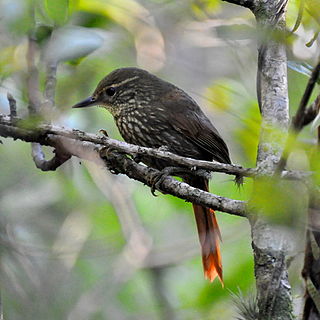
Penelopides is the genus of relatively small, primarily frugivorous hornbills restricted to forested areas of the Philippines. Their common name, tarictic hornbills, is an onomatopoetic reference to the main call of several of them. They have a ridged plate-like structure on the base of their mandible. All are sexually dimorphic: males of all species are whitish-buff and black, while females of all except the Mindoro hornbill are primarily black.

The green honeycreeper is a small bird in the tanager family. It is found in the tropical New World from southern Mexico south to Brazil, and on Trinidad. It is the only member of the genus Chlorophanes.

The tuftedcheeks are a genus, Pseudocolaptes, of passerine birds in the ovenbird family Furnariidae. They are found in the mountains of the tropical New World from Costa Rica to Bolivia.

Cinclodes is a genus of passerine birds belonging to the ovenbird family Furnariidae. There are about a dozen species distributed across the southern and Andean regions of South America. They are terrestrial birds of open habitats, typically found near water such as mountain streams or the seashore where they forage for small invertebrates. They are stocky birds with strong legs and feet and pointed, slightly downcurved bills. The plumage is inconspicuous and mainly brown, often with a pale wingbar, stripe over the eye and corners to the tail. They have loud, trilling songs and often raise their wings while singing.

Tit-spinetails are small passerine birds of the genus Leptasthenura, belonging to the ovenbird family Furnariidae. They are found in South America, particularly the southern and Andean parts of the continent. They are somewhat similar to birds of the tit family in their shape and feeding behaviour, hence the first part of their name. The "spinetail" part of their name refers to their long, pointed tail feathers. Tit-spinetails have short rounded wings, short pointed bills and are mainly brown in colour. Their nests are built in holes or in the old nests of other birds.

Chalcostigma is a genus of South American hummingbirds in the family Trochilidae.

Discosura is a genus of South and Central American hummingbirds in the family Trochilidae. The thorntails are sometimes placed in the genus Popelairia, leaving Discosura for the racket-tailed coquette. On the contrary, some have argued for merging this genus into Lophornis, which they overall resemble, except for the highly modified tail-feathers of the males.

Periporphyrus is a genus of grosbeaks in the cardinal family Cardinalidae.

Canasteros and thistletails are small passerine birds of South America belonging to the genus Asthenes. The name "canastero" comes from Spanish and means "basket-maker", referring to the large, domed nests these species make of sticks or grass. They inhabit shrublands and grasslands in temperate climates from the lowlands to the highlands. They feed on insects and other invertebrates gleaned from the ground or the low vegetation.

Automolus is a genus of bird in the ovenbird family Furnariidae.

The pale-browed treehunter is a species of bird in the Furnariinae subfamily of the ovenbird family Furnariidae. It is endemic to Brazil.

The typical spinetails, Cranioleuca, are a genus of Neotropical birds in the ovenbird family Furnariidae.

Lepidocolaptes is a genus of birds in the ovenbird family Furnariidae. These are relatively small woodcreepers with fairly long, thin and slightly decurved bills.

Margarornis is a genus of passerine birds in the ovenbird family Furnariidae. They are found in South and Middle America. All four species in the genus have "treerunner" in their English name.

Phacellodomus is the genus of thornbirds, birds in the family Furnariidae. They are found in woodland, shrubland and grassland, often near water, in South America.

The cacholotes are four species of relatively large, heavy-billed furnariids in the genus Pseudoseisura. They are found in shrubby habitats in the South American countries of Brazil, Bolivia, Argentina, Paraguay and Uruguay. They are essentially brown, and all are crested to some extent.

Syndactyla is a genus of foliage-gleaners, birds in the ovenbird family Furnariidae.

Thripadectes is a genus of Neotropical birds in the ovenbird family Furnariidae.

Cyanomitra is a genus of African sunbirds. Its members are sometimes included in Nectarinia.

The cryptic treehunter is or was a species of bird in the Furnariinae subfamily of the ovenbird family Furnariidae. Its status, and even its existence as a species, are disputed. It is or was endemic to Brazil.




















